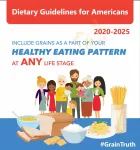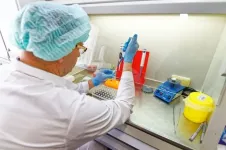(Press-News.org) After "COVID-19," the term that most people will remember best from 2020 is likely to be "social distancing." While it most commonly applied to social gatherings with family and friends, it has impacted the way many receive medical care. Historically, the United States has been relatively slow to broadly adopt telemedicine, largely emphasizing in-person visits.
However, the COVID-19 pandemic, especially in the spring of 2020, necessitated increased use of virtual or phone call visits, even prompting the Center for Medicare and Medicaid Services (CMS) to relax some of its regulations, primarily for video-based telemedicine. These large scale changes made telemedicine exponentially more popular than it had been even at the start of the calendar year.
But while this was a positive for those who otherwise would have delayed or foregone care due to the pandemic, a new study led by researchers in the Perelman School of Medicine at the University of Pennsylvania, published in JAMA Network Open, uncovered significant inequities, particularly by race/ethnicity, socioeconomic status, age, and when someone needed to use a language other than English.
"As we begin to establish novel ways of caring for our patients via telemedicine, it is critical that we make the foundation of this new way forward equitable," said the study's senior author, Srinath Adusumalli, MD, an assistant professor of Cardiovascular Medicine and the University of Pennsylvania Health System assistant chief medical information officer for connected health. "We hope that regulatory and payer organizations recognize potential inequities that could be introduced by policies they create -- which might include not reimbursing for telephone visits, and potentially leading to lack of access to care for particular patient populations, specifically those disproportionately affected by events like the COVID-19 crisis."
The researchers, who included the study's lead author, Lauren Eberly, MD, a clinical fellow in Cardiovascular Medicine, examined data for nearly 150,000 patients of a large, academic medical system. All of these patients had been previously scheduled to have a primary care or ambulatory specialty visit between March 16 and May 11, 2020. This time period coincided with the first surge of coronavirus in the health system's region, and was also amid stay-at-home orders in the area.
Of the patients who had visits previously scheduled, a little more than half, roughly 81,000 (54 percent), conducted their visits via telemedicine, the data showed. And within that segment, less than half, nearly 36,000, (46 percent) had visits conducted via video.
When these visits were broken down by the patients' characteristics, some clear inequities were found. Overall, patients who were older than 55 were 25 percent less likely than the average patient to successfully participate in a telemedicine visit, with people older than 75 being 33 percent less likely. People who identified as Asian were 31 percent less likely to conduct a telemedicine visit, and those who did not speak English were 16 percent less likely. Using Medicaid for insurance also made patients less likely to successfully conduct a telemedicine visit by 7 percent.
Because of the relaxation of CMS rules surrounding video-based telemedicine early in the pandemic, it's important to consider that mode of telemedicine in a class by itself. So when those numbers were examined, some of the same groups showed even less favorable numbers than they had for overall telemedicine use. For instance, people over 55 were at least 32 percent less likely to conduct a video visit, with those over 75 being 51 percent less likely.
Meanwhile, some groups of people were shown to have significant disparities in video-based telemedicine even if they hadn't displayed them for overall telemedicine use. This likely means that they didn't have problems accessing telemedicine if it was phone or audio-based, but video was not as accessible to them. More, women were 8 percent less likely to participate in a video visit than men, Latinx patients were 10 percent less likely than White patients, and Black people 35 percent less likely than White people. Patients with lower household incomes were also less likely to conduct a video visit, with those making less than $50,000 being 43 percent less likely.
While the CMS has recently attempted to make phone call-based telemedicine easier to access from a reimbursement perspective, the researchers believe their findings show that there needs to be equal consideration for all forms of telemedicine moving forward.
"It is critical that complete payment parity for all types of telemedicine visits, by all insurance payers, is guaranteed permanently," Eberly said. "Less reimbursement for telephone visits may disproportionately and unjustly hurt clinics and providers that care for minority and poorer patients."
Penn Medicine has long implemented a practical approach to root out technical issues that may play a role in access issues. Specifically, professionals within the health system work with patients to assess whether they have the technical ability to successfully have a visit. That includes checking Wi-Fi speed and whether the patient has devices physically capable of conducting the visit.
Something since the start of the COVID-19 outbreak that Adusumalli said Penn Medicine addressed was the inequity found for non-English speakers.
"One concrete thing that has already been addressed, based on the results of this study, was adding one-click interpreter integration for more than 40 video-based languages and greater than 100 audio-based languages for both inpatient and outpatient telemedical care throughout our enterprise," he explained.
Moving forward, the researchers hope they can uncover more ways to make telemedicine work for everyone, including facilitating broadband and digital device access.
"We currently have broader research underway to better characterize what patient-specific and provide-specific barriers exist," Eberly said. "If we can understand these barriers, it could help guide telemedicine implementation strategies that will benefit everyone."
INFORMATION:
N-Aryl-C-nitroazoles are an important class of heterocyclic compounds. They are used as pesticides and fungicides. However, these substances could be toxic to humans and cause mutations. As they are not frequently used, there is little data about them in the medicinal chemistry literature. However, it has been suggested recently that the groups of compounds that are traditionally avoided can help to fight pathogenic bacteria. Yet, to reduce toxic effects, a great amount of work must be carried out at the molecular level, ...
The flag leaf is the last to emerge, indicating the transition from crop growth to grain production. Photosynthesis in this leaf provides the majority of the carbohydrates needed for grain filling--so it is the most important leaf for yield potential. A team from the University of Illinois and the International Rice Research Institute (IRRI) found that some flag leaves of different varieties of rice transform light and carbon dioxide into carbohydrates better than others. This finding could potentially open new opportunities for breeding higher yielding rice varieties.
Published ...
In a study that looked at suicide deaths during 2020's first wave of the COVID-19 pandemic in Maryland, Johns Hopkins Medicine researchers found that, contrary to general predictions of suicides skyrocketing, suicides in the overall population actually dropped, relative to previous years. However, the researchers also discovered that suicide deaths increased dramatically among Black Marylanders during the same period.
The researchers say that their findings, published Dec. 16, 2020, in JAMA Psychiatry, highlight the importance of timely identification of high-risk groups and vulnerable populations to reduce suicide numbers.
Black Americans have been ...
LOS ANGELES -- Scientists from the UCLA Jonsson Comprehensive Cancer Center have developed a simple, high-throughput method for transferring isolated mitochondria and their associated mitochondrial DNA into mammalian cells. This approach enables researchers to tailor a key genetic component of cells, to study and potentially treat debilitating diseases such as cancer, diabetes and metabolic disorders.
A study, published today in the journal Cell Reports, describes how the new UCLA-developed device, called MitoPunch, transfers mitochondria into 100,000 or more recipient cells simultaneously, which is a significant improvement from existing mitochondrial transfer technologies. The device is ...
AURORA, Colo. (Dec. 29, 2020) - College football players may underestimate their risk of injury and concussion, according to a new study published today in JAMA Network Open.
Christine Baugh, PhD, MPH, assistant professor of medicine at the University of Colorado School of Medicine and member of the CU Center for Bioethics and Humanities, is the corresponding author of the article, "Accuracy of US College Football Players' Estimates of Their Risk of Concussion or Injury."
Baugh and co-authors report on survey results of 296 college football players from four teams in the Power 5 Conferences of ...
People have puzzled for years why pathogen Phytophthora infestens causes the devastating late blight disease, source of the Irish Potato famine, on potatoes, but has no effect at all on plants like apple or cucumber. How are apple trees and cucumber plants able to completely shake off this devastating pathogen? Agricultural scientists have wondered for years: if this resistance is so complete and persists over so many generations, is there some way we could transfer it to susceptible plants like wheat and thereby stop disease?
Why is it so important to determine the molecular basis of nonhost resistance? ...
Toronto - With the arrival of effective vaccines for the COVID-19 virus, the end of the pandemic is on the horizon but in the short term the virus continues to spread.
A timely new study published today by PLOS ONE examines the effectiveness of COVID-19 control policies in 40 jurisdictions including countries and U.S. states.
Among the conclusions is that significant social costs must be incurred to reduce the growth of the virus below zero. In most jurisdictions examined, policies with a lesser social impact including cancellation of public events, restrictions of gatherings ...
The Grain Chain, a farm to fork coalition of stakeholders in the grain industry sector and chaired by the American Bakers Association (ABA), celebrates the recommendation published today in the 2020-2025 Dietary Guidelines for Americans (DGAs) to "consume half of your grains from whole grain sources" and the remainder from enriched grains. A foundational piece of the DGAs, the guidelines recognize whole grains are "one of the three food groups that are fundamental constituents of a healthy dietary pattern."
The United States Department of Agriculture (USDA) and Health and Human Services (HHS) oversee and publish the Dietary Guidelines, ...
BIRMINGHAM, Ala. - COVID-19, which has killed 1.7 million people worldwide, does not follow a uniform path.
Many infected patients remain asymptomatic or have mild symptoms. Others, especially those with comorbidities, can develop severe clinical disease with atypical pneumonia and multiple system organ failure.
Since the first cases were reported in December 2019, the SARS-CoV-2 virus that causes COVID-19 has surged into a pandemic, with cases and deaths still mounting. Ongoing observational clinical research has become a priority to better understand how this previously unknown virus acts, and findings from this research can better inform treatment and vaccine design.
University ...
Carrageenans, biologically active polysaccharides isolated from red algae and widely used in the food industry as stabilizers, thickeners, or jelly agents have an express effect on the immune systems of mice, a study reports. The research was carried out by scientists from the School of Biomedicine of Far Eastern Federal University (FEFU), Far Eastern Branch of the Russian Academy of Sciences, and Vilnius University. A related article appears in the Journal of Biomedical Materials Research.
"The fact that carrageenan demonstrates immunosuppressive properties in a particular case does not make it generally dangerous or toxic though", says Aleksandra ...




